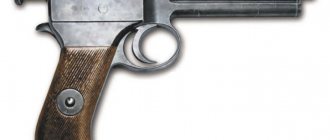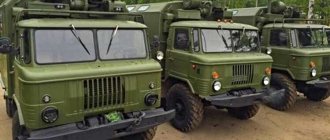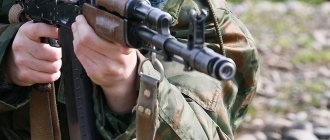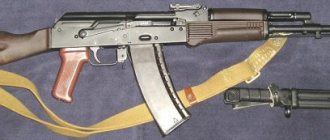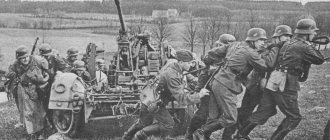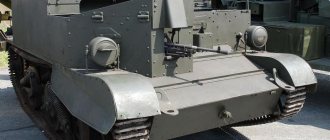Balanced automatic
In Izhevsk, they have repeatedly tried to design Kalashnikov assault rifles of 5.45 mm caliber using balanced automatics. The first among them were the prototypes of Yu. K. Aleksandrov AL-4, AL-6 and AL-7, created in the late 60s and early 70s.
Aleksandrov's assault rifles reached the final stage of the competition for a new Soviet Army assault rifle chambered for a low-pulse cartridge, where they lost to another competitor from Izhevsk - the A-3 assault rifle (the future AK74), which, together with the Kovrov SA-006, went further to the military testing stage.
AL-7 assault rifle with the receiver cover removed
© kalashnikov. media
In the 80s, development work (R&D) of the Abakan began, in which balanced automation again participated as a means of achieving the goal of increasing the efficiency of the AK74 assault rifle by 1.5 times. Work in this direction in Izhevsk this time was led by V. M. Kalashnikov, the son of Mikhail Timofeevich. First, the AL-9 assault rifle saw the light of day as a logical continuation of Alexandrov’s work. Then two other Kalashnikov models were presented to the competition - AKB and AKB-1, maximally unified with the AK74 already adopted for service.
All samples with balanced automatics showed a slight improvement in firing characteristics with a significant complication of the design. Nevertheless, they still had great potential in increasing the accuracy of fire. The scheme with a displacement of the recoil impulse, which was used by G. A. Nikonov, Kalashnikov’s colleague at the Izhevsk design workshop, proved to be much more successful. His “Abakan” went through the entire difficult path of state tests and, under the name AN-94, was adopted by the Russian army.
The story of “balanced” AKs did not end there. Such a weapon gave an advantage in firing efficiency by 2-3 times in comparison with the AK74, which, in turn, exceeded the same conditional parameter for the AN-94. After the successful launch of the “hundredth” AK series into production, it was decided to expand the line of assault rifles with “high-precision” models. So at the end of the 90s, the 5.45 mm AK107, 5.56 mm AK108 and 7.62 mm AK109 appeared. In the 7.62x39 mm caliber, no improvement in shooting results could be achieved, and they decided to abandon further development of the AK109. The history of low-impulse options lasted much longer. The AK107 assault rifle actually reached testing in 2012 as part of the Ratnik R&D project. The military history of the AK107 did not work out, but in civilian life the carbine in .223Rem caliber was put into mass production under the name first “Saiga-MK-107” and then SR1.
Specifications
Design and technical characteristics of the modernized version of the AK-74M
The technical characteristics of the AK-74 are considered based on the base model. Modifications have certain differences in dimensions and weight, and the indicators also change in the case of specific additions - the use of other cartridges, new mechanisms or other devices.
Disassembly and device
AK-74 consists of the following elements:
- receiver, barrel;
- receiver cover;
- sighting bar, front sight;
- shutter, bolt frame;
- compensator or muzzle brake;
- gas exhaust tube, cover plate;
- trigger mechanism;
- forend, butt;
- shop.
Partial disassembly of the machine is carried out in the following order:
- remove the store;
- check the presence of a cartridge in the chamber, make a control trigger;
- remove the pencil case with accessories and take them out;
- separate the cleaning rod;
- remove the muzzle brake-compensator;
- remove the receiver cover;
- separate the return mechanism;
- separate the bolt frame with the gas piston and bolt from the receiver;
- remove the shutter;
- separate the gas tube from the barrel lining.
The assembly order after such disassembly is as follows:
- attach a gas tube with a barrel lining to the barrel;
- attach the bolt to the bolt frame;
- install the bolt frame with a gas piston and bolt on the receiver;
- attach the return mechanism;
- return the receiver cover to its place;
- release the trigger and put the safety on by pressing the trigger and raising the translator all the way up;
- attach the muzzle brake and cleaning rod;
- return the accessories to the pencil case, install it in the butt socket;
- attach store.
Maintenance and operation of the AK 74 is one of its key advantages. The assault rifle, like its predecessor, is easy to learn and has minor changes compared to the AK-47, which simplified the transition to new weapons.
Caliber
Brief characteristics of the modernized version
The caliber of the machine gun is 5-45 mm. According to the performance characteristics, the following cartridges can be used when firing:
- 7N6 with 1974 bullets that had a steel core, lead jacket and full metal jacket;
- 7N10 from 1992 - bullets with increased penetration and a heat-strengthened core;
- 7U1 - subsonic bullet for silent shooting, not used;
- 7N22 1998 - armor-piercing bullet with a high-carbon steel core;
- 7T2 - tracer bullet;
- 7X3(M) - blank cartridge;
- 7Х4 — training cartridge;
- 7N39 is an experimental armor-piercing cartridge with a tungsten carbide bullet core.
The improvement of cartridges of a given caliber is aimed at increasing armor-piercing power. Penetration of a steel helmet and an army vest is taken into account.
Initial bullet speed
The initial speed of the AK-74 bullet is 910 m/s. Several values are taken into account for the range of destruction:
- single ground and air targets - 500 m;
- for group ground targets - 1000 m.
Compared to the AKM, the accuracy of fire of the new machine gun has almost doubled. When shooting single shots, accuracy increased by 50%.
Rate of fire
The rate of fire of the AK-74 is approximately 600 rounds per minute. Taking into account this indicator and the magazine capacity, the ammunition is consumed in just three seconds of continuous shooting.
Dimensions and weight
In terms of dimensions, the AK-74 has the following indicators:
- length - 940 mm, with bayonet - 1089;
- length of the rifled part of the barrel - 372 mm;
- total barrel length - 415 mm, with muzzle brake - 485;
- width - 10 mm, with sights - up to 140;
- height - 195 mm, with sights - up to 310.
The weight of the machine gun without a magazine is 3.3 kg, the weight of the loaded weapon is 3.6 kg. The modified version of the AK-74M is 0.3 kg heavier.
Aim
The standard AK-74 sight is open. There are modifications for installing night sights. The modernized AK-74M allows the installation of several sight options, including collimator ones. The presence of a sight increases the weight of the weapon to almost 6 kg, depending on the type.
Magazine capacity
The capacity of a standard magazine is 30 rounds, staggered. The weight of an empty chamber is 0.23 kg, full - 0.3. Power supply from an RPK-74 magazine with 47 rounds is allowed.
Izhevsk machine gun with Tula filling
In 2011, on the eve of Izhmash’s participation in the competition for new army assault rifles, the chief designer was changed in Izhevsk. It was the leading designer of the Tula Central Design Research Bureau of Sports and Hunting Weapons (TsKIB SOO) V.V. Zlobin. It was he who led the work on the first Kalashnikov assault rifle of the 2012 model. This is how the first AK-12 with balanced automatics appeared. However, Izhevsk developments were always one step behind the Kovrov competitors.
The Ratnik design and development project envisioned the development of weapons in two calibers (5.45×39 mm and 7.62×39 mm) and required the provision of an automatic fire option with a cut-off of two shots (a similar requirement existed within the Abakan design and development work). By the first stage of preliminary tests in 2012, Izhmash presented the 5.45 mm AK107 and 7.62 mm AK103−3, the latter of which, in fact, was just a prototype of the modern AK203 and was forced to replace the AK109. By the second stage of testing in 2013, the original 5.45 mm AK-12 was already ready, which, despite the above-mentioned requirements for automatic fire, had a series cut-off option of three shots. It is not surprising that the Izhevsk versions of the “Warrior” ultimately did not satisfy the requirements of the technical specifications (TTZ), as did the Tula 5.45A-91 and 7.62A-91.
The exact specifications of the Ratnik OCD assault rifle have not been announced in the media. At the same time, in the general requirements for individual assault weapons of the second generation of combat equipment of the Russian military personnel in the late 2000s within the framework of the Barmitsa-N2 R&D (later became the Ratnik), one of the main points was to ensure reliable destruction of manpower in class 5 armor protection with a probability of at least 50% at distances up to 600 m. In addition, reliability of the design and ease of use, no increase in the weight of the weapon in comparison with standard models, as well as the inclusion of collimator sights and silent firing devices (for units) were assumed special forces).
It is worth noting that the development of the AK-12 was accompanied by a noisy PR campaign and a lot of promising statements. Thus, a modular design of the machine gun was announced, on the basis of which it was planned to develop weapons of various calibers for special and civilian purposes, such as an automatic carbine, an assault rifle, a light machine gun, and even a shotgun and a submachine gun. In addition to the standard magazine, the AK-12 could use box magazines with 60 rounds and disc magazines with 95 rounds. All this hype was a consequence of the catastrophic lag behind the competitor and an attempt to attract attention to its product.
AK-12 assault rifle, 2015.
© Photo by Konstantin Lazarev
Until the beginning of 2015, the last attempts were made to save the failing Izhevsk project with Tula roots. The belated appearance of the AK-12 assault rifle in 7.62×39 mm caliber did not help either. It is not surprising that the Izhevsk versions of the “Ratnik” did not pass state tests, and further development was possible only at the expense of the developer.
Return to the classics
As a result, the Zlobin AK-12 was never destined to become the new fifth-generation Kalashnikov assault rifle. In Izhevsk they decided to forget about the unsuccessful attempts of the AK74M3 and AK103−3 to become new weapons flagships. It was on their basis that a new project appeared under the working title AK400. For its successful implementation, the main “helmsman” was also changed, who became S.V. Urzhumtsev, who had previously worked at Vyatsko-Polyansky.
The new team stopped inventing the “21st century assault rifle” and focused on what Izhmash has been doing well for more than 70 years—making simple and reliable automatic weapons. As a result, by the beginning of 2015, two new models appeared without unnecessary fanfare - AK-12 and AK-15. For some reason, they decided not to abandon the old name for the 5.45 mm machine gun - perhaps this was dictated by the desire to emphasize that all the previously expended effort and resources were not in vain. The 7.62 mm assault rifle received a new, quite logical designation as a 2015 model assault rifle.
Full set of AK-15
© kalashnikov.
media As a result, the new assault rifles were indeed significantly different from the AK-12 model of 2012-2014, but were practically no different from the AK103-3 and later AK203. Despite the lack of balanced automatics, according to the terms of the competition, the new generation of AKs still has the “deuces” firing cutoff, which is unloved by Izhevsk residents. Rather, as in the case of the AK103−2, this will save ammunition when training inexperienced soldiers to shoot, which will lead to increased shooting efficiency. However, according to the developer, the gas exhaust unit and receiver of the AK-12/AK-15 were modified, which made it possible to increase the accuracy of fire in all modes.
Comparison of AK200 (top) and AK-12 (bottom)
© ak.
kalashnikovgroup.ru Thus, thanks to tenacity and perseverance, the Kalashnikov concern was able to wedge itself into a serious and equal fight against Kovrov assault rifles within the framework of the Ratnik R&D project. If Kovrov products, when firing at a distance of up to 300 m, had an advantage in fire efficiency of 1.1 times, then shooting over 300 m gave the same advantage to Izhevsk machine guns. Moreover, the same figure was twice as high for the 6P70 and 2.3 times higher for the 6P68 than for the AK74M. This is not the first time that the Main Rocket and Artillery Directorate (GRAU) has had to compromise in order to satisfy all interested parties. A Solomon decision was made - to divide the competition into promising general-arms and special-purpose assault rifles, similar to the recent selection of an army pistol within the framework of the Boa constrictor design and development project. It is obvious that the role of “soldier’s” weapon went to the Izhevsk machine guns.
As a result, in 2016 and 2022, the AK-12 and AK-15 successfully passed state and military tests. In 2022, the assault rifles were recommended for adoption and received the corresponding GRAU indices 6P70 and 6P71. The customer received the first 8,000 assault rifles in mid-2022, and the Russian Ministry of Defense will receive the entire batch of 150,000 AK-12 and AK-15 in 2022 (a year earlier than the stated date). Again, on their own initiative, shortened versions of the AK-12K and AK-15K were developed with a barrel length similar to the compact versions of the “hundredth” and “two hundredth” AK series.
AK-15, AK-12 and AK-15K assault rifles
© kalashnikov.
media The results of the “Warrior” competition have been summed up, the winners have been determined, but the details have not yet been published, which means that the “debriefing” by specialists, weapons lovers and journalists is still ahead. Be that as it may, the good old AK74, which received a new fashionable “clothes”, became the “Kalashnikov assault rifle of the 21st century”.
* - experimental machine gun model 2014 designed by V.V. Zlobin
Advantages and disadvantages
Distribution of the AK-74 in the world
The advantages of the AK-74 include:
- reliability of the machine gun in operation, including combat conditions;
- ease of production, development and operation;
- increased accuracy and reduced recoil compared to its predecessor.
The advantages of the weapon include support for modern devices in the modernized version of the AK-74M. This applies not only to the use of different sights, but also to the use of box magazines with side inserts showing the ammunition.
Among the shortcomings of the machine gun, low shooting accuracy with single shots is noted in comparison with the M16A2 and M4A1. However, burst shooting in the same comparison is more accurate with the AK-74. Accuracy is significantly reduced when firing from unstable positions.
Among the disadvantages is the lack of ability to quickly replace the barrel. The fixed-length burst firing mode was added only to the “hundredth” versions of the machine gun. Also, the AK-74 receiver does not allow the installation of a Picatinny rail.
This limits the use of various sights; it is necessary to use a dovetail mount, which disrupts the alignment of the weapon and increases its weight. They also note the lack of changing the firing mode with one hand; the direction of ejection of the cartridge case is not adjustable, as is the reloading lever.

